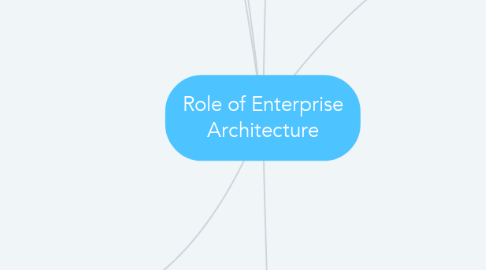
1. Impact to the enterprise if the role did not exist
1.1. Increased potential for: - chaos and confusion - inadequate information to support key decisions - complexity - local vs enterprise optimization - reduced efficiency and effectiveness - increased risk of finding the wrong solution
2. Competencies most needed to be effective on the role
2.1. analytical change management
2.2. communication
2.3. interpersonal
2.4. leadership
2.5. management
2.6. modeling
2.7. problem solving skills
2.8. business acumen and technical acumen
3. How the architect interface with other roles
3.1. Business strategist includes
3.1.1. Includes
3.1.1.1. mission communities
3.1.1.2. members of executive steering committees
3.1.1.3. business analysts
3.1.1.4. strategic planners
3.1.2. To help formulate and better understand the strategic vision
3.2. External stakeholders
3.2.1. Includes
3.2.1.1. citizens
3.2.1.2. businesses
3.2.1.3. other government organizations
3.2.2. to ensure that
3.2.2.1. their interests are adequately represented in the enterprise architecture
3.2.2.2. to collaborate on optimizing the architecture to best serve their collective needs.
3.2.3. Decisions are made through the governance structure.
3.3. Ffunctional groups
3.3.1. such as engineers and human resource specialists
3.3.2. to better understand constraints or requirements that must be factored into the EA,
3.3.3. assist the functional groups in understanding the complexities of the architecture
3.3.3.1. the architecture is properly implemented to achieve the desired performance outcomes
3.3.3.2. help ensure that each group is collaborating with the appropriate other groups.
3.3.4. critical to ensure that everyone understands and aligned with the strategic goals that will result in realization of a shared vision.
3.4. Other enterprise architects at different levels of the enterprise
3.4.1. To ensure concordance of the architectures and oversees the quality of the EA.
3.4.2. Enterprise architects are accountable to several oversight groups which require continual coordination and collaboration with staff and members of these oversight groups and committees to ensure compliance with laws, policies and directives.
3.4.2.1. Unites States Congress
3.4.2.2. GAO
3.4.2.3. the agency Inspector General
3.4.2.4. OMB
3.5. Senior executives
3.5.1. To seek and give advice.
3.5.2. interface with chief executive officers such as department/cabinet level secretaries
3.5.2.1. to ensure that they fully understand the vision of the enterprise leaders.
3.5.2.2. to ensure that senior executives are cognizant of the level of commitment in terms of resources needed to execute the different architectural options so that practical choices are made that can be realized.
4. Key functions performed by the enterprise architect
4.1. Creates the path from the present to the future - taking a holistic view of the enterprise - integrate the business plan with technical capabilities
4.1.1. Must be aware of: - the capabilities that exist - challenges of the business for linkage needed to achieve optimal result
4.1.2. Example: - recognize the potential of capabilities (data warehouse & data mining)for better integration and utilization of enterprise information
4.2. Understands: - how each capability supports organizational goals and objectives - how each of the process, roles and technology must be integrated to achieve desired results
5. Benefits provided by the unique role of enterprise
5.1. Aligning technology with the business goals and objectives
6. Where the roles most effective within the organizational structure
6.1. Change management
6.1.1. To facilitate the implementation of the target enterprise architecture.
6.1.2. Able to instill a level of confidence to make change while working out some of the lower level details that come from the design details.
6.1.3. Interpersonal skills - The architect needs to project an image of helping rather hindering.
6.2. Communication skills
6.2.1. Critical competence to be an effective enterprise architect who must communicate concepts to people who are - generally pragmatic in their thinking - struggle with understanding and expressing concepts.
6.2.2. To bridge the communications gap between various disciplines.
6.3. Leadership
6.3.1. To be able to help create a vision that everyone is motivated
6.3.2. To achieve and provide the guidance needed to make the vision achievable.
6.3.3. To run the architecture program and manage the process.
6.3.4. It entails acquiring - resources - setting schedules - establishing priorities - scoping the effort so that the architecture can provide utility without becoming a burden.
6.4. Modeling
6.4.1. Identified as a competency needed by the enterprise architect.
6.4.2. The enterprise architect needs to be able to model reality in a naturally graphic manner with detailed drawings illustrating complex relationships.
6.4.3. The broad categories of functional interfaces for the enterprise architect
6.4.3.1. business
6.4.3.2. strategists
6.4.3.3. capital investment planners
6.4.3.4. external stakeholders
6.4.3.5. functional groups
6.4.3.6. other architects
6.4.3.7. oversight officials
6.4.3.8. program/project managers
6.4.3.9. senior executives.
6.4.4. The enterprise architect must interface with everyone in the enterprise who need to have
6.4.4.1. a clear understanding of strategic direction of the enterprise
6.4.4.2. the plan of execution to move the enterprise in that direction
6.4.4.3. anyone outside of the enterprise who has a stake in the enterprise’s outcomes.
